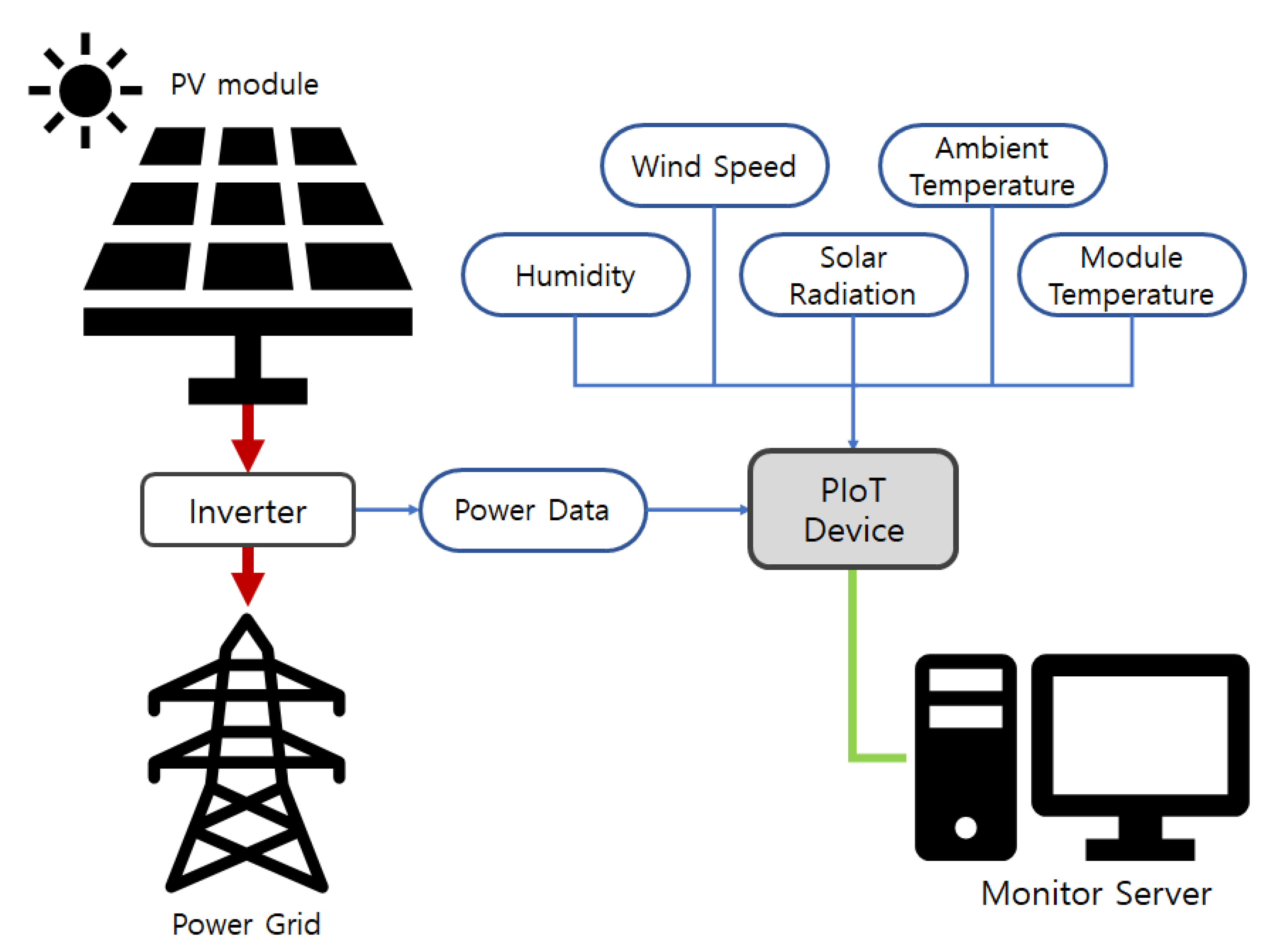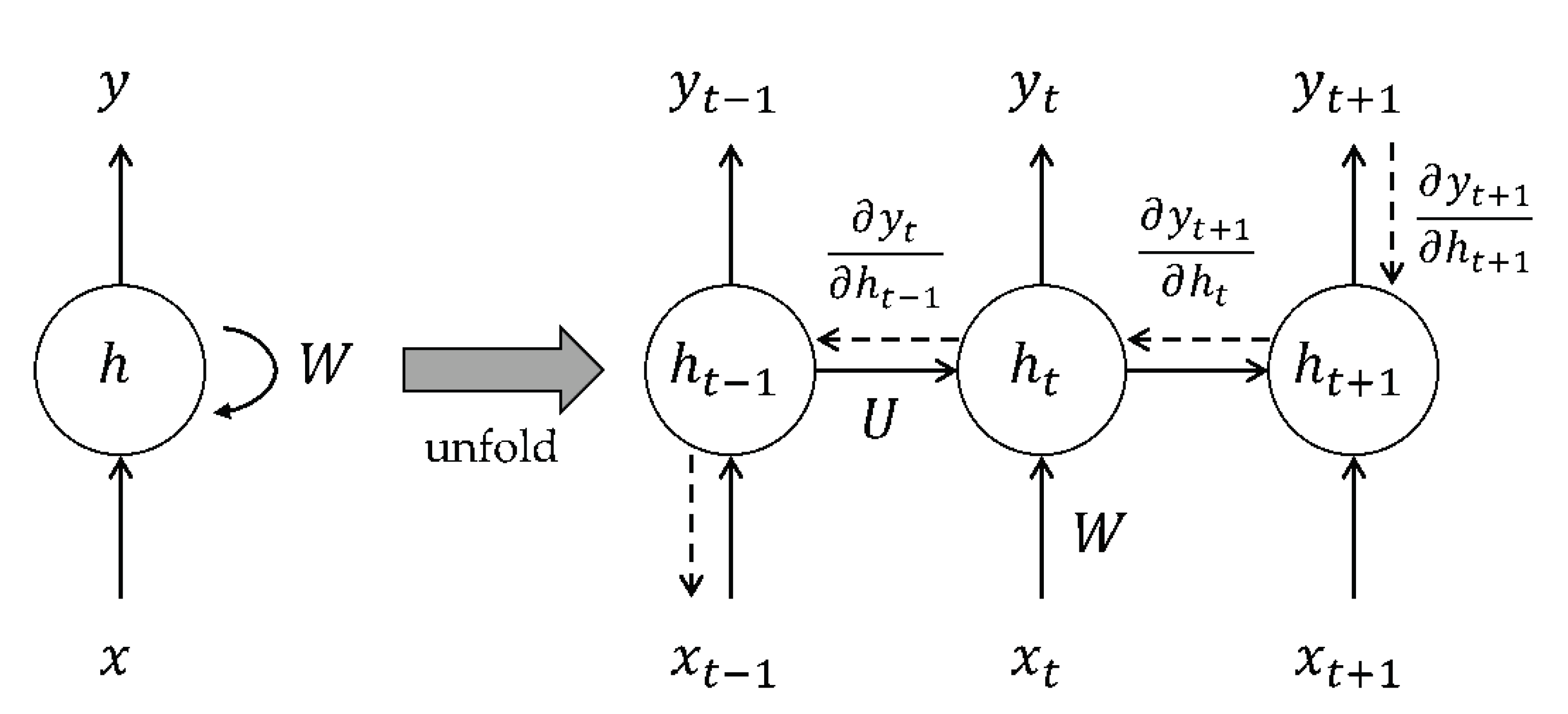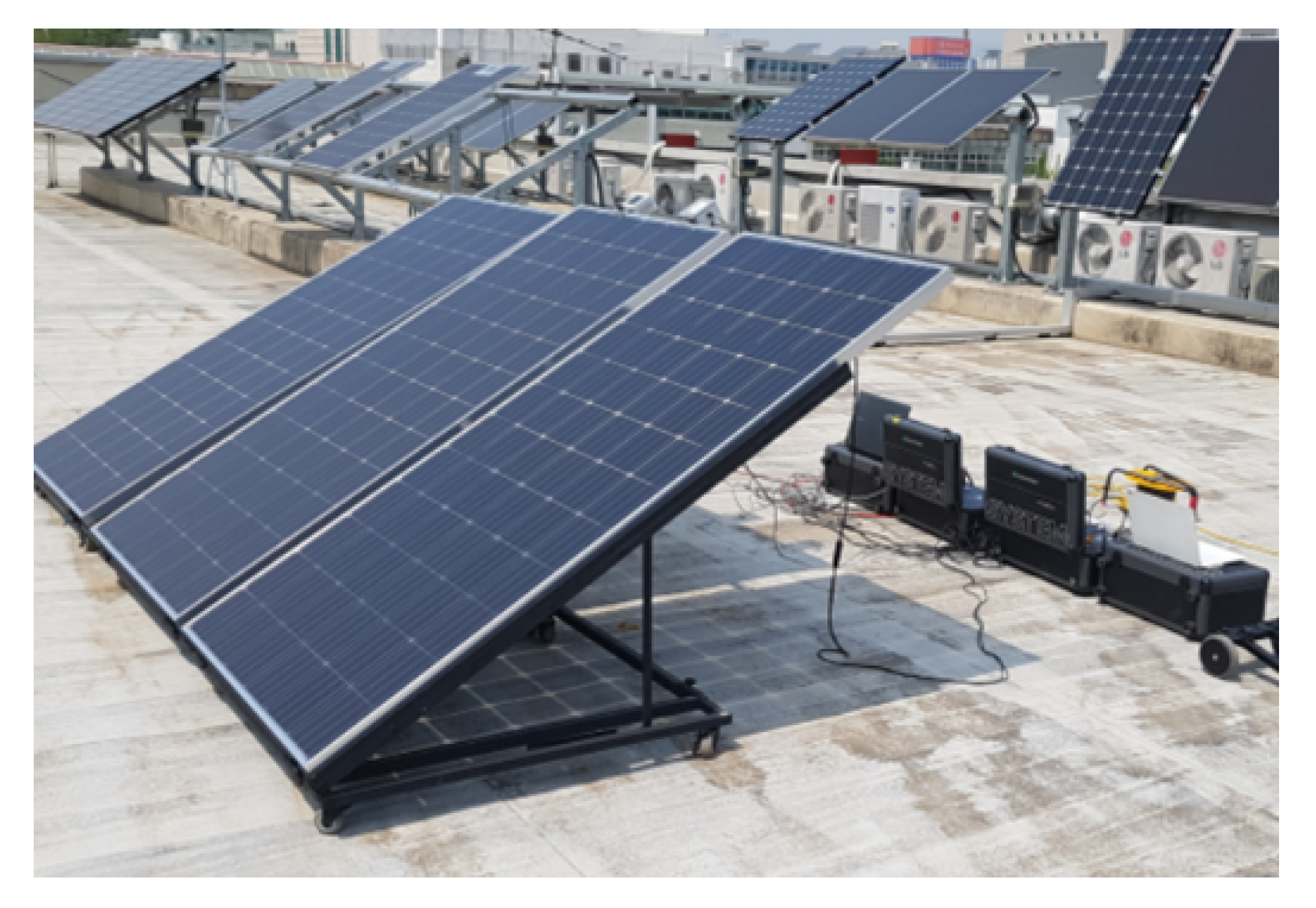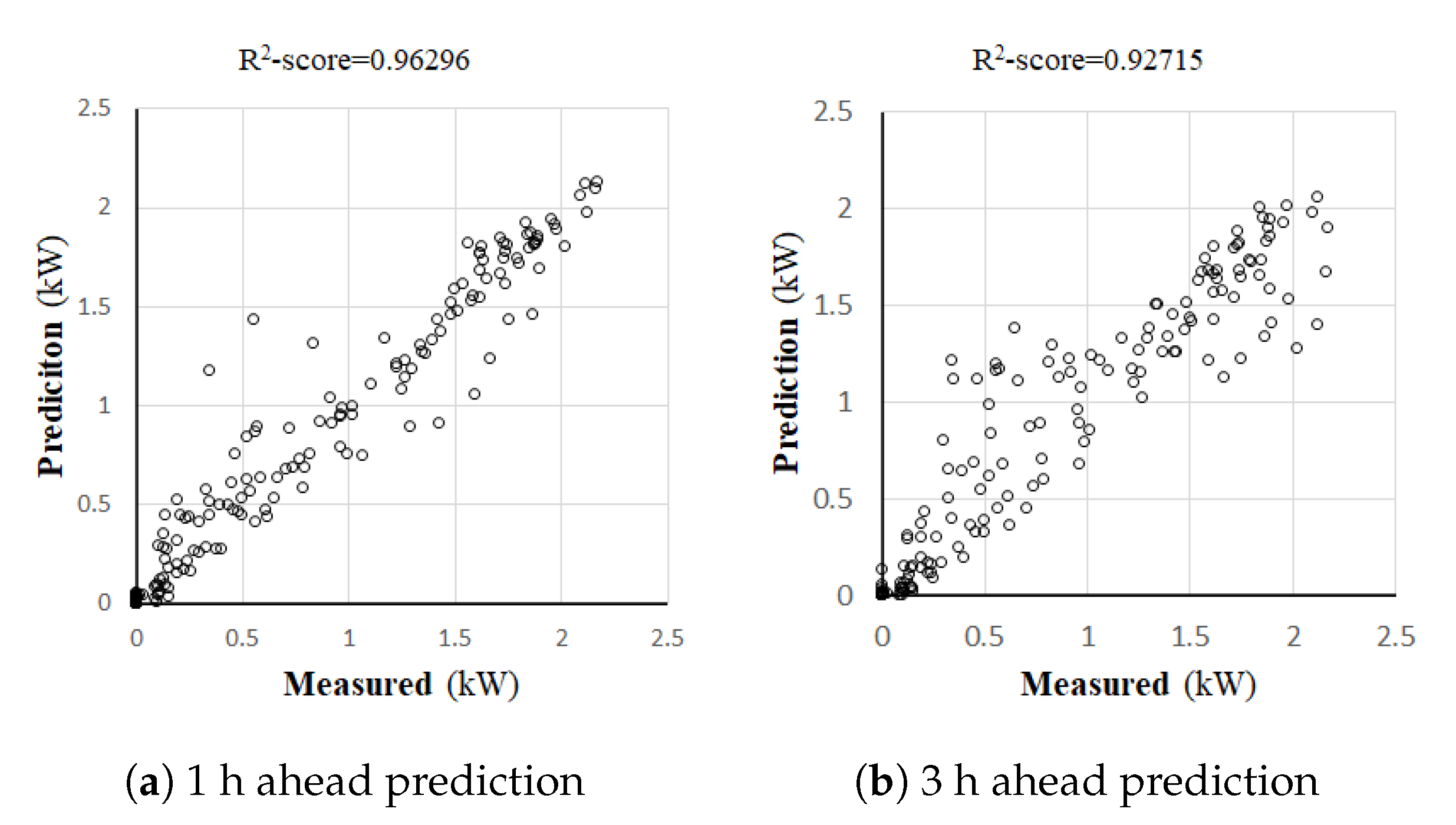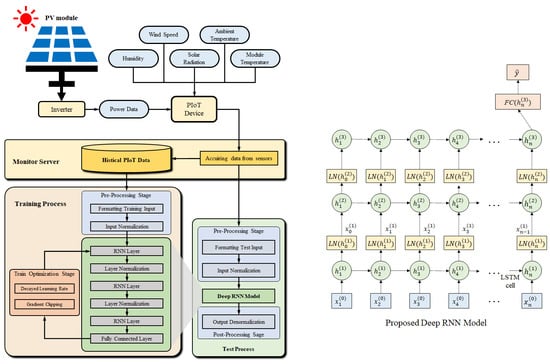1. Introduction
Most of the electrical energy was supplied through fossil fuels. As the use of fossil fuels for power generation increases, concern for environmental pollution increases. Accordingly, unexhausted and clean renewable energy, such as solar energy and wind energy, becomes more significant and attracts more attention. The International Renewable Energy Agency (IRENA) reported that the world renewable energy capacity increased to 2537 GW in 2019 [
1]. Solar energy is one of the promising renewable resources as a substitute for fossil fuels. In particular, the photovoltaic (PV) system steeply increased more than 14 times over 10 years, the capacity of which was from 41.5 GW in 2010 to 586.4 GW in 2019.
As the portion of PV power in the total electrical energy increases, the impact of PV power generation on the power grid is also increasing. PV power fluctuates rapidly with daytime weather changes due to cloud shadows and rainfalls [
2]. This PV power fluctuation penetrates the power grid, causing a short-term mismatch between power supply and demand. It leads to instability and inefficiency of the power grid operation. Managing a power grid stably and efficiently requires short-term PV power forecasts to respond to PV power fluctuation [
3,
4,
5].
The statistical and machine learning methods, such as ARMA (Auto-Regressive Moving Average), ARIMA (Auto-Regressive Integrated Moving Average), and regression models, were studied to forecast PV power generation [
6,
7,
8]. Various neural network approaches, like artificial neural networks (ANN), gray prediction model [
9], BP-ANN model [
10], and the radial basis function (RBF) network [
11], were proposed. To further improve the accuracy of PV power prediction, hybrid models were developed [
12,
13]. Those previous studies were based on historical PV power and weather data and were not suitable for real-time short term PV forecasting.
The online sequential extreme learning machine with a forgetting mechanism (FOS-ELM) was introduced to the short-term PV power prediction [
14]. Predicted data computed by a weather forecast model was used as input to the PV prediction model. However, it required a large amount of computation for weather forecasting. A hybrid one-day-ahead power forecasting model was proposed, combining wavelet transform, particle swarm optimization, and support vector machine (Hybrid WT-PSO-SVM) [
15]. It used the actual power data from PV power system SCADA (Supervisory Control and Data Acquisition) and numerical weather forecast meteorological data for one year with one-hour time step. To forecast daily generated PV power, several LSTM-RNN models were studied [
16]. Wavelet-based LSTM-DNN model was proposed [
17], which used predicted temperature and solar radiation for the short-term PV power prediction. Also, to enhance the short-term (24 ahead) forecasting accuracy of distributed PV power output, an adaptive hybrid predictor subset selection strategy was proposed, which combined binary genetic algorithm (BGA) and support vector regression (SVR) [
18]. For a real-time short-term PV power forecast, feature data were collected at 5-min intervals [
19], where a weighted Gaussian process regression was proposed to detect outliers in the data for improving the prediction accuracy.
We propose a short-term PV power generation forecast algorithm based on the deep recurrent neural network (RNN) in the paper. To reflect the impact of weather changes, the proposed model utilizes the on-site weather IoT dataset and power data, collected in real-time. To build a model using low-cost and low-computation power, we used only IoT sensors without image data, such as solar radiation, module temperature, ambient temperature, wind speed, and humidity. In experiments, we investigated the best combination of parameters to improve forecast accuracy. The proposed deep-RNN consists of multiple RNN layers. Each RNN layer includes long-short term memory (LSTM) and layer normalization units. For experiments, a very short-term forecast algorithm predicts a power 5 or 15 min ahead. A short-term forecast algorithm also predicts a power 1 h or 3 h ahead. The experimental results showed that the very short-term forecast accuracy was 99.01% (nMAE)/98.02% (nRMSE) for 5 min ahead prediction and 98.16% (nMAE)/96.58% (nRMSE) for 15 min ahead prediction using three RNN layers. And the short-term prediction accuracy was 93.75% (nRMSE) and 96.6% (nMAE) for 1 h ahead prediction and 90.29% (nRMSE) and 94.7% (nMAE) for 3 h ahead prediction.
This paper organizes as follows.
Section 2 describes the photovoltaic power generation system and Power IoT data. In
Section 3, the short-term PV power forecasting algorithm based on deep-RNN is proposed. The experimental results and performance evaluation are discussed in
Section 4, and then the conclusion is summarized in
Section 5.
5. Conclusions
In this paper, we proposed the deep RNN-based short-term forecast algorithm of PV power generation. For the proposed short-term forecast of PV power generation, we collect on-site power and weather information using PIoT sensors installed in a PV power system since on-site accurate weather information is significant for the short-term prediction accuracy. We performed a correlation analysis between the PV generated power data and meteorological data collected in a PV system to select the weather parameters. The correlation analysis confirmed that solar power was affected by solar irradiation, ambient temperature, and module temperature. Furthermore, we found that humidity and wind speed are significant meteorological features to the change of the PV power through experimental investigations. The proposed short-term forecast of PV power generation is designed based on a deep-RNN model using PIoT data. It consists of one input layer, three hidden RNN layers, and one fully connected output layer. The sequence inputs are normalized, and their outputs are denormalized.
To evaluate the performance of short-term forecast PV power, we performed various experiments according to the number of hidden layers, sampling data interval, and the time steps of a deep RNN-based forecast model. Experimental results showed that the prediction accuracy was the best when it consists of 3 hidden RNN layers and 12 time-steps in each RNN layer. In the experiments for the very short-term forecasting algorithm of PV power generation, the prediction accuracy was 99.1% (nMAE)/98.0% (nRMSE) regarding 5 min ahead forecast, and 98.6% (nMAE) 96.6% (nRMSE) regarding 15-min ahead forecast. The R-scores of them were 0.988 and 0.949, also. In the experiments for the short-term forecasting algorithm of PV power generation, the prediction accuracy was 94.8% (nRMSE) and 97.4% (nMAE) regarding 1 h ahead forecast and 92.9% (nRMSE) and 96.2% (nMAE) regarding 3 h ahead forecast. The R-scores of 1 h and 3 h ahead prediction were 0.963 and 0.927, respectively. Experimental results showed that the proposed deep RNN-based short-term forecast algorithm achieved higher prediction accuracy compared with ARIMA and SVR-RFN models.
To improve the current short-term PV power generation forecast model, we will develop new deep learning forecast models using other weather features like a cloud image and dust sensors in the future. We will study an abnormality detection method in the PV power system based short-term forecast algorithm. We expect that it will be useful for floating or marine photovoltaics.
